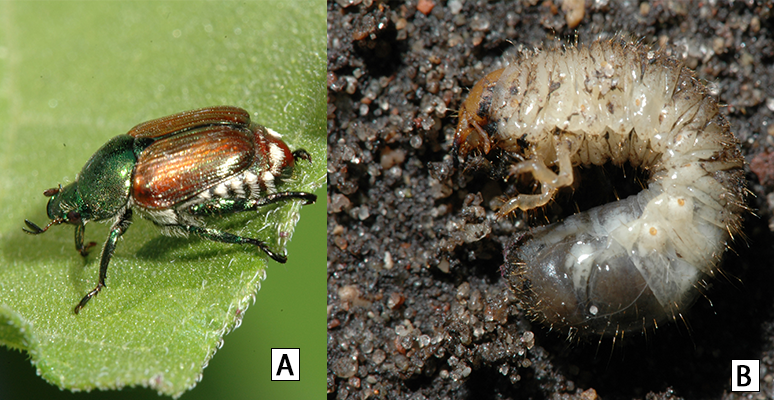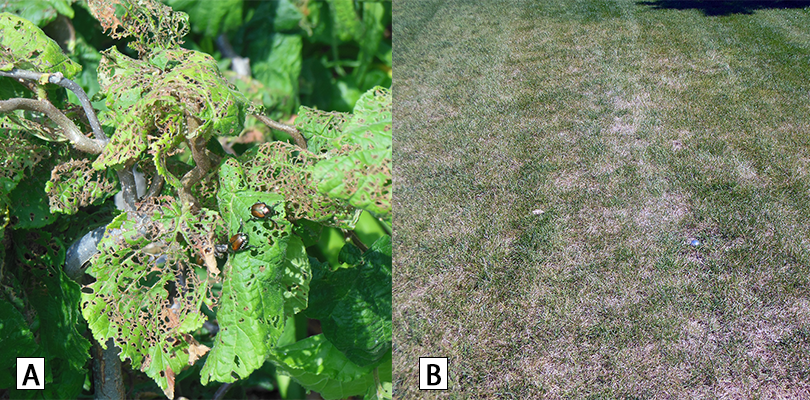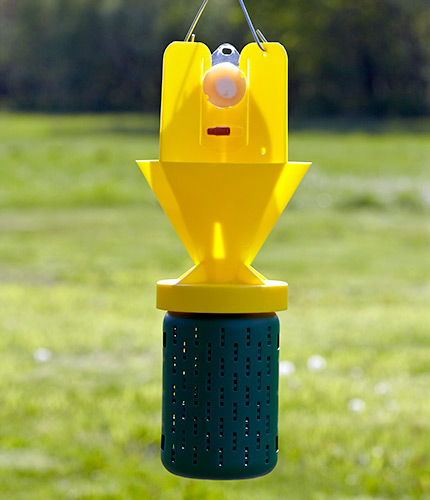(Popillia japonica Newman)
New Mexico is currently free of the Japanese beetle, but this pest could be introduced by importing infested soil and plant material from another state that has Japanese beetle. For this reason, New Mexico has implemented a Japanese Beetle Exterior Quarantine to prevent the movement of nursery plants and turf grass from being shipped into the state that could potentially be infested with Japanese beetle.

The Japanese beetle is a significant pest of landscape plants and turf grasses. The adult is a shiny green beetle with brown wing covers (elytra) and white hair tufts along the sides of its abdomen (1A). Beetle adults feed on the leaves (2A), flowers, and fruits of plants they inhabit. The larvae (1B), a white grub that lives in the soil, feeds on the roots of affected plants (2B).

The New Mexico Department of Agriculture (NMDA) conducts Japanese beetle survey programs annually to monitor for accidental introductions into the state. Traps that are specifically designed to collect Japanese beetle adults are placed in a survey area and are used in combination with a lure to attract the adult beetles (3). Businesses, nurseries, and other plant traffic areas that are at risk of Japanese beetle introductions are selected as trapping locations. Monitoring allows NMDA staff to identify beetles and arrange eradication efforts as early as possible to prevent establishment.

If this destructive pest is established, it will result in increased pesticide use and will negatively impact the aesthetic value of plants associated with landscapes, parks, golf courses, and residential areas.
Quarantine for Nurseries
If you are a New Mexico plant nursery, ensure you know the requirements before importing nursery stock or plant stock from a Japanese beetle infested state.
- Regulated nursery stock includes:
- plants in pots or rootballs greater than 12 inches, and any grass or turf imported into New Mexico.
- The importing nursery is responsible for:
- Ensuring all shipments originating from a U.S. state or territory are accompanied with the required quarantine related documents:
- A phytosanitary certificate issued by the state of origin for each specific nursery shipment. The certificate should specifically address the requirements stated in New Mexico’s Japanese beetle quarantine.
- Or a New Mexico Department of Agriculture-approved compliance agreement with the exporting nursery may be used.
- Ensuring imported plant stock meets all other state quarantine law (e.g. red imported fire ant).
- Ensuring all shipments originating from a U.S. state or territory are accompanied with the required quarantine related documents:
Japanese Beetle Quarantine NMAC
Non-Compliant Stock
State law allows NMDA staff to inspect nursery documentation to ensure compliance with state laws. Staff is authorized to address non-compliance to protect the interests of the state. Staff will immediately remove all non-compliant stock from sale and require the importing nursery to do one of the following:
- Destroy stock in a manner approved by the inspector.
- Immediately return stock to state of origin.
Japanese Beetle downloadable PDF
